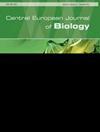In Vitro Characterization of Chitosan-Based Particles as Carrier of Influenza Viral Antigens
引用次数: 0
Abstract
DOI : 10.26650/EurJBiol.2018.0004 Objective : Chitosan is a natural polysaccharide derived from chitin by deacetylation. It is a non-toxic, biocompatible and biodegradable polymer, and has attracted considerable interest in a wide range of pharmaceutical applications including drug and vaccine delivery. The immune-stimulating activity of chitosan microparticles such as the activation of macrophages and polymorphonuclear leukocytes has been reported. In this work, we have investigated the releasing properties of influenza virus antigens from the chitosan microparticles and beads. Materials and Methods : Chitosan microparticles and beads were prepared by coacervation and ionotropic gelation method, respectively. The microparticles and beads were loaded with the viral antigens by passive adsorption and/or entrapment into the microparticles. The titration of the viruses was defined by haemagglutination assay or by quantitation of viral proteins using the Bradford method. Results : The results showed that the loading efficiency and the loading capacity of chitosan microparticles/beads with the viral antigens and the releasing profiles of the antigens from the particles changed depending on the type of chitosan, the pH of the loading buffer and the methods used to prepare the particles. The influenza viral antigens, passively adsorbed onto microparticles/beads, were released within 2 hours to 5 days. In contrast, the viral antigens entrapped into the chitosan microparticles were released more slowly and continued for up to 30 days. Conclusion : It was concluded from the viral antigen releasing profiles of chitosan particles that the viral antigens entrapped into the microparticles are more suitable for in vivo applications as a potential mucosal vaccine.壳聚糖基流感病毒抗原载体颗粒的体外表征
目的:壳聚糖是一种天然多糖,由几丁质脱乙酰化而成。它是一种无毒、生物相容性和可生物降解的聚合物,在包括药物和疫苗输送在内的广泛制药应用中引起了相当大的兴趣。壳聚糖微粒的免疫刺激活性,如巨噬细胞和多形核白细胞的活化已被报道。在本研究中,我们研究了壳聚糖微颗粒和微珠对流感病毒抗原的释放特性。材料与方法:采用凝聚法制备壳聚糖微粒,采用离子化胶凝法制备壳聚糖微珠。通过被动吸附和/或包埋的方式将病毒抗原装入微颗粒和微珠中。通过血凝试验或Bradford方法对病毒蛋白进行定量来确定病毒的滴定。结果:壳聚糖微球/微珠对病毒抗原的负载效率、负载能力和抗原的释放谱随壳聚糖的种类、负载缓冲液的pH和制备方法的不同而变化。流感病毒抗原被被动地吸附在微粒/珠上,在2小时至5天内释放。相比之下,包裹在壳聚糖微粒中的病毒抗原释放速度较慢,并持续长达30天。结论:壳聚糖颗粒的病毒抗原释放谱表明,壳聚糖颗粒包裹的病毒抗原更适合作为潜在的粘膜疫苗在体内应用。
本文章由计算机程序翻译,如有差异,请以英文原文为准。
求助全文
约1分钟内获得全文
求助全文

 求助内容:
求助内容: 应助结果提醒方式:
应助结果提醒方式:


